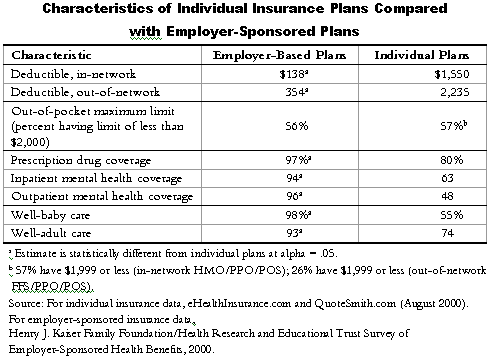This paper examines the comparative financial protection provided by individual and group health insurance. Data sources include two national surveys of employer- based health plans and e-health insurance listings for individual coverage on the World Wide Web. Data on the use and cost of services are from the National Medical Expenditure Survey (NMES), a national household survey of Americans. We estimate that individual insurance pays on average 63 percent of the health care bill, whereas group health insurance pays 75 percent. Deductibles are much higher in individual insurance, and covered benefits are more meager. At 200 percent of poverty, the top 25 percent of health care users with individual coverage would spend 11 percent of their income for out-of-pocket health care expenses, as opposed to 6 percent for persons with group coverage.
Under proposals put forth by the Bush administration and members of Congress, tax credits would be extended to uninsured Americans for the purpose of purchasing health insurance. By taking this approach to reducing the number of uninsured, policy officials would greatly depend on the individual insurance market, where products are heavily underwritten and offer substantially less financial protection than group health coverage.
In an analysis of the relative value of individual and group health insurance, Individual Insurance: How Much Financial Protection Does it Provide?, Jon Gabel and colleagues at the Health Research and Educational Trust found that individual insurance pays substantially less of the average health care bill compared with employer-sponsored group insurance—63 percent versus 75 percent. Patient cost-sharing is significantly greater for individual policies, which also typically offer fewer benefits than group plans.
Covering 16 million Americans, individual health insurance policies account for roughly 7 percent of the health coverage sold to Americans under age 65. Unlike insurance offered by large employers, companies selling individual policies in most states undertake vigorous medical underwriting on each applicant. As a result, those covered by individual health insurance tend to be in good health.
Individual insurance—long viewed as a "residual" market—is taking center stage in policy proposals designed to provide health coverage for people not enrolled in employer group plans. With this backdrop, Gabel and colleagues set out to evaluate the financial protection afforded under individual insurance now available. The researchers found these policies are characterized by:
- Substantial patient cost-sharing requirements. In-network deductibles average $1,550 in individual policies compared with $138 in employer-sponsored plans, while out-of-network deductibles average $2,235 and $354, respectively.
- Inferior benefits. While nearly all group coverage includes some level of prescription, mental health, and well-baby and well-adult care benefits, significantly fewer individual policies include such coverage. What's more, 56 percent of employer-sponsored plans limit out-of-pocket costs for covered persons to $2,000 or less. Only 11 percent of fee-for-service individual policies include such out-of-pocket maximums.
- Wide variability of coverage among individual insurance policies. While individual insurance covers 63 percent of medical costs on average, half of people buying individual policies are covered for just 30 percent of the health care bill.
- Average premiums vary considerably by age, even among the healthy. The average monthly premium in 2000 for a 27-year-old male with no medical conditions was $132, one-third the average for group coverage. The average monthly premium in 2000 for a healthy 55-year-old man was $313, about 60 percent higher than group premiums. Costs for individual policies rise substantially for less-healthy individuals.

Many low-cost policies are available in the individual market, particularly for the young and healthy. However, these low-cost policies limit what they cover. A healthy 27-year-old male, for example, can buy one-quarter of individual plans for $816 or less per year. But these low-cost policies would pay only 42 percent of incurred health care costs for the policyholder.
A healthy 55-year-old male policyholder buying a low-cost policy would pay considerably more¾25 percent of individual policies for such a person cost less than $2,184 annually¾and still see the policy cover less than half (42%) of incurred medical costs.
Since insurance is designed to protect families from large and unpredictable expenses, the authors set out to calculate the expected percentage of income a person earning 200 percent of the poverty level would likely spend for coverage, excluding premium costs. They found that the top 25 percent of health care users would pay out-of-pocket a total of $1,829, or 11 percent of income, on medical services. That compares with $997, or 6 percent of income, the top one-quarter of health care users with group coverage would spend.
While the uninsured can purchase many low-cost individual policies for a $1,000 tax credit, they may have to use substantial portions of their income to cover medical expenses. For example, a healthy 55-year-old man at 200 percent of the poverty level who receives a $1,000 tax credit and purchases an average-priced policy could ex-pect to pay 17 percent of his income in premiums and out-of-pocket expenses.
Some health policy experts believe tax credits would spur positive changes in the individual insurance market, resulting in less medical underwriting, reduced administrative costs, and lower premiums. Others contend a strong set of rules is needed to make this market efficient. While it is not clear what form the individual market would take under a system of tax credits, it is certain in today's market that those individuals who can pass the medical underwriting screen are buying a product that affords far less protection than what persons with group coverage enjoy.
Facts and Figures
- Employer-sponsored health insurance covered about 158 million workers, dependents, and retirees in 1999, while 16 million Americans purchased individual health insurance that year.
- Individual insurance covers nearly 20 percent of self-employed persons and 17 percent of farm workers. Others purchasing this coverage include early retirees, those employed by companies not offering health insurance, individuals not in the workforce, and those who have exhausted COBRA coverage.
- Administrative expenses constitute 25 to 40 percent of each premium dollar for individual insurance, but just 10 percent of the premium dollar among large employer groups.